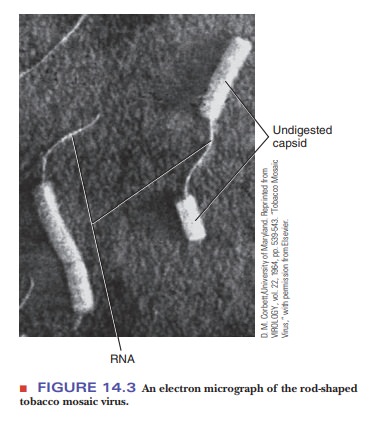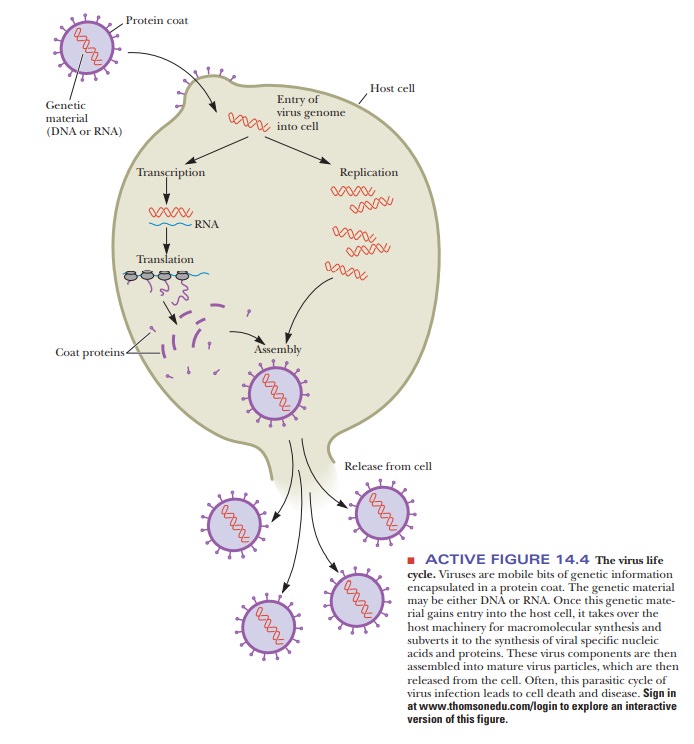Chapter: Biochemistry: Viruses, Cancer, and Immunology
Viruses

Viruses
Viruses have always been difficult to classify according to normal
taxonomy. Many have argued over whether they should be considered living
things. They cannot reproduce independently, and they cannot make proteins or
generate energy independently, so they do not meet all of the requirements for
life as we have traditionally defined it. But if they are not life forms, what are
they? The simplest definition would be a relatively small amount of genetic
material surrounded by a protein envelope. Most viruses have only one type of
nucleic acid, either DNA or RNA. Depending on the virus, this nucleic acid
could be either single-stranded or double-stranded.
Why are viruses important?
Viruses are known for the diseases they cause. They are pathogens
of bacteria, plants, and animals. Some viruses are deadly, such as the
fast-acting Ebola virus, which can
have a mortality rate of more than 85%, and the slow-acting but equally deadly human immunodeficiency virus (HIV),
which causes acquiredimmunodeficiency
syndrome (AIDS). Other viruses might be simply annoying,such as rhinovirus, which causes common colds.
What is the structure of a virus?
Viruses are very small particles composed of nucleic acid and
protein. The entire virus particle is called the virion. At the center of the virion is the nucleic acid.
Surrounding this is the capsid,
which is a protein coat. The combination of the nucleic acid and the capsid is
called the nucleocapsid, and, for
some viruses, such as the rhinovirus, that is the extent of the particle. Many
other viruses, including HIV, have a membrane
envelope surrounding the nucleocapsid. Many viruses also have protein spikes that help it attach to
its host cell. Figure 14.1 shows the main features of a virus.

The overall shape of a virus varies. The classic viral shape most
often seen in the literature has a hexagonal capsid with a rod sticking out of
it that attaches to the host cell and acts like a syringe to inject the nucleic
acid. Figure 14.2 shows the T2 bacteriophage of E. coli, a classic example of a virus of this shape. Tobacco mosaic
virus (TMV), on the other hand, has a rod shape, as shown in Figure 14.3.


Families of Viruses
Although many characteristics distinguish viruses, most are organized by whether they have a genome of DNA or of RNA and whether they have an envelope. In addition, the nature of the nucleic acid (linear vs. circular, small vs. large, single-stranded vs. double-stranded) and the mode of incorporation (nucleic acid remains separate vs. nucleic acid joins with host chromosome) distinguishes the different virus types. Table 14.1 shows some of the known viral diseases and the families of viruses that cause them.

Virus Life Cycles
Most viruses cannot survive for long periods outside cells, so they must quickly gain access to a cell. There are several mechanisms for gaining access, and preventing access to the cell has been a major focus of pharmaceutical companies trying to develop antiviral drugs.
Figure 14.4 shows a
generic example of a virus infecting a cell. The virus binds to the cell
membrane and releases its DNA into the cell. The DNA is then replicated by host
DNA polymerases and transcribed by host RNA polymerases. The transcription and
translation of the mRNA leads to the proteins that are necessary to make the
coat proteins of the capsid. New virions are produced and then released from
the cell. This is called the lytic
pathway, as the host cells are lysed by this process.

Viruses do not always lyse their host cells, however. A separate process called lysogeny involves the incorporation of the viral DNA into the host chromo-some. Simian virus 40 (SV40) is an example of a DNA virus. It appears to be spherical, but it is actually an icosahedron, a geometric shape with 20 faces that are equilateral triangles, as shown in Figure 14.5.

The
genome of this virus is a closed circle of double-stranded DNA, with genes that
encode the amino acid sequences of five proteins. Three of the five proteins
are coat proteins. Of the remaining two proteins, one, the large-T protein, is
involved in the develop-ment of the virus when it infects a cell. The function
of the fifth protein, the small-T protein, is not known.
The outcome of infection by SV40 depends on the organism infected.
When simian cells are infected, the virus enters the cell and loses its protein
coat. The viral DNA is expressed first as mRNAs and then as proteins. The large-T
protein is the first one made (Figure 14.6), triggering the replication of
viral DNA, followed by viral coat proteins. The virus takes over the cellular
machin-ery for both replication of DNA and protein synthesis. New virus
particles are assembled, and eventually the infected cell bursts, releasing the
new virus par-ticles to infect other cells.

The results are different when SV40 infects rodent cells. The
process is the same as far as the production of the large-T protein, but
replication of the viral DNA does not take place. The SV40 DNA already present
in the cell can be lost or can be integrated into the DNA of the host cell. If
the SV40 DNA is lost,
How does a virus infect a cell?
A virus must attach to a host cell before it can penetrate, which is why so much research is involved in studying the exact mechanisms of viral attachment. A common method of attachment involves the binding of one of the spike proteins on the envelope of the virus to a specific receptor on the host cell. Figure 14.7 shows an example of HIV attachment. A specific spike protein called gp120 binds to a CD4 receptor on helper T cells. After this happens, a co-receptor complexes with CD4 and gp120. Another spike protein, gp41, then punctures the cell so that the capsid can enter.

Summary
Viruses are simple genes, made up of RNA or DNA, that infect cells
and take over their replication, transcription, and translation machinery.
Viruses are characterized by their structure, their type of nucleic
acid, whether it is single- or double-stranded, and their mode of infection.
Viruses are known to cause many diseases, and they may be very
specific to a particular species and cell type.
Viruses enter the cell by binding to specific receptors on the
cell. Once inside the cell, the virus may replicate, form new viruses, and
burst the cell.
The virus may also hide its DNA by incorporating it into the host’s
DNA.
Related Topics